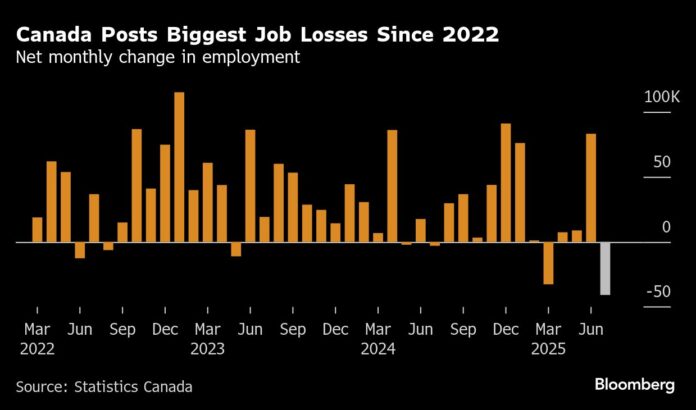By Randy Thanthong-Knight
(Bloomberg) — The Canadian economy lost the most jobs since January 2022, and excluding the pandemic, it’s the largest drop in seven years.
Employment fell by 40,800 positions in July, driven by decreases in full-time work, while the jobless rate held firm at 6.9%, Statistics Canada data showed Friday. The number of job losses surpassed even the most pessimistic projection in a Bloomberg survey of economists.
The monthly decline was concentrated among youth ages 15 to 24, who are usually among the first to experience a labor-market downturn. Their unemployment rate reached 14.6%, the highest since September 2010 outside of the pandemic. The employment rate for youth fell to the lowest since November 1998, excluding the years impacted by Covid-19.
The Canadian government two-year bond yield fell about four basis points on the day to 2.654%, while the loonie weakened to C$1.3762 per US dollar as of 8:52 a.m. in Ottawa. Traders in overnight swaps fully priced in a quarter-point rate cut by the Bank of Canada by year-end, and boosted the odds of a September cut to about 40%, from 30% previously.
The Canadian labour market failed to sustain its strong momentum from June, when it surprisingly added the most jobs in six months. The Bank of Canada held its policy interest rate at 2.75% for a third straight meeting last week, but said the labour market remains soft, with the unemployment rate rising from 6.6% at the beginning of the year.
Of the 1.6 million people who were unemployed in July, 23.8% had been continuously searching for work for 27 weeks or more. This was the highest share of long-term employment since February 1998, not including the pandemic.
Compared with a year earlier, unemployed job searchers were more likely to remain jobless from one month to the next. Nearly 65% of those who were unemployed in June remained so in July, versus 56.8% from a year ago. The layoff rate, however, was virtually unchanged.
The employment rate — the proportion of the working-age population that’s employed — fell 0.2 percentage points to 60.7% in July. It was down 0.4 percentage points from the start of this year.

“There’s still more than a month to go until the Bank of Canada’s next interest rate decision, and therefore a lot more data to be released between now and then, including another employment report, two inflation releases and quarterly GDP,” Andrew Grantham, economist at Canadian Imperial Bank of Commerce, said in a report to investors.
“However, today’s weaker than expected employment figure is nevertheless supportive for our call of a 25 basis point interest rate reduction at that September meeting.”
The report confirms the Bank of Canada’s view that the June employment number was an anomaly and the labor market remains soft, Charles St-Arnaud, chief economist at Alberta Central, said in an email.
“As long as core inflation remains above the target band, it will be difficult for the Bank of Canada to cut interest rates unless there are signs of significant deterioration in the economy,” he added.
“With this in mind, we believe the Bank of Canada will cut its policy rate but the timing is dependent on easing inflationary pressures, with the cut more likely in October than September, in our view.”
The private sector lost 39,000 jobs last month, and public-sector employment was little changed. Job losses were driven by information, culture and recreation, as well as construction and business, building and other support services. Transportation and warehousing added jobs for the first time since January.
Employment fell in Alberta and British Columbia, while it was virtually unchanged in Ontario and held steady in Quebec. Saskatchewan was the only province to record job increases in July.
Total hours worked fell 0.2% in July, and were up 0.3% from a year earlier.
Yearly wage growth for permanent employees accelerated to 3.5%, from 3.2%, versus economist expectations for compensation gains to slow to 3.1%.
–With assistance from Mario Baker Ramirez.
Visited 1,265 times, 1 visit(s) today
andrew grantham bloomberg Charles St-Arnaud Dashboard economic data economic indicators economic news Editor’s pick statcan statcan employment statistics canada unemployment rate
Last modified: August 8, 2025
